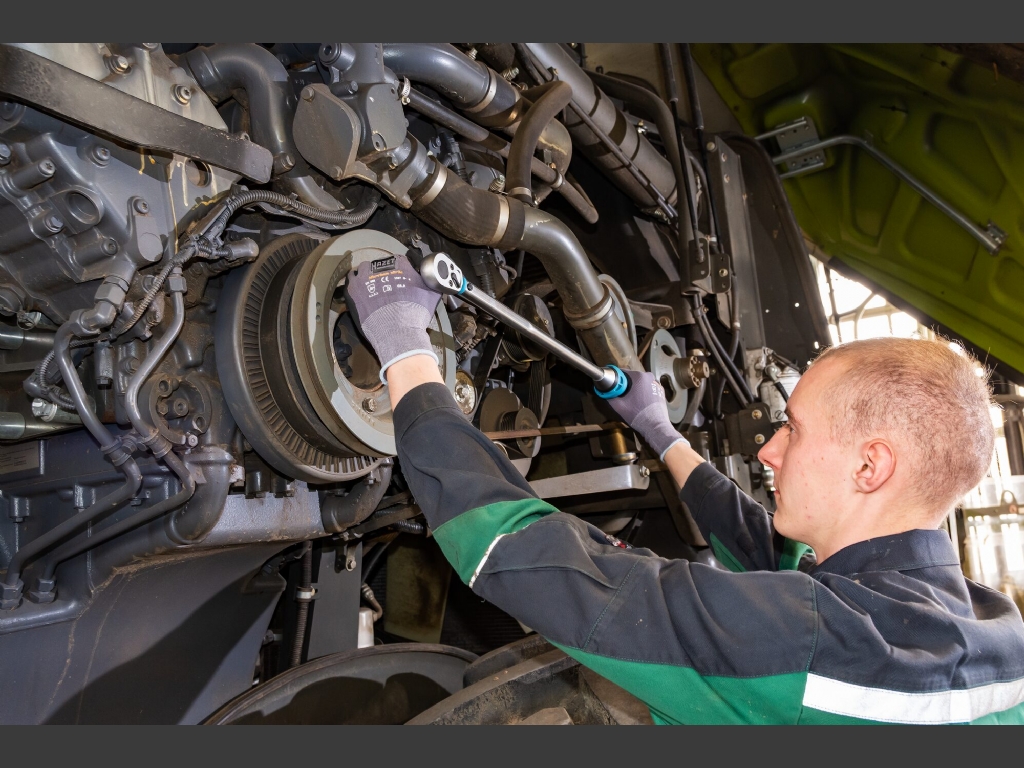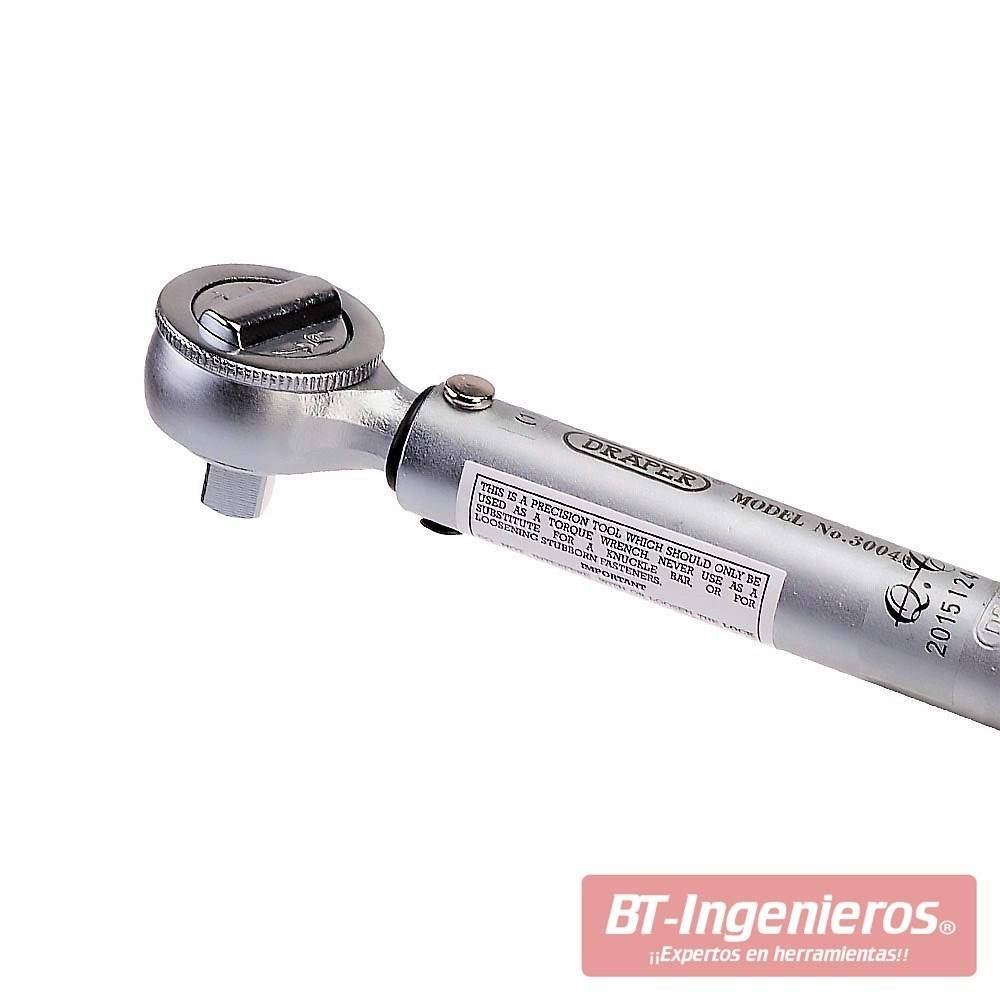Aircraft Torque Wrench - Various torque wrenches are shown here. The beam-type wrench at the bottom works well for checking the tightness of the alternator belt, but it can be used for many other torque jobs. The central wrench is a click-type, 1/4-inch drive. The tip is the more commonly used 3/8-inch drive model with a torque range high enough to do prop bolts.
Torque is a twisting or rotational force about an axis such as the length of a bolt. It is measured in foot-pounds, inch-pounds or newton meters. These units can also be displayed as pound-feet and pound-inch. These are just different ways of saying the same things.
Aircraft Torque Wrench

When installing aviation fasteners (nuts and bolts), we use torque to determine how tight the connection made by the nut or bolt in question. We care about this because a bolted connection is designed to maintain its tightness when the design load is applied to it without loosening. This is accomplished by placing an amount of tension in the bolt or pin that is greater than the expected load. If a connection is too tight—that is, over-twisted—the bolt can fail. If it is too loose, it can allow movement in the connection under load which can lead to displacement of the joint, fatigue and possible failure. Improper tightness of things like propeller flanges can cause the track of the prop to wobble, potentially causing many problems. So, achieving the right amount of tightness in a nut, bolt or stud is very important.
File:us Navy 110805 N Ee987 129 Aviation Boatswain's Mate (equipment) Airman Troyphilip Obuga, From The Philippines, Uses A Torque Wrench.jpg
The torque wrench is the tool of choice for aerospace fasteners, not so much because it produces the best results, but because the tight standards we must use rely on torque. Engineers will tell you that to measure the tightness of a joint we actually have to measure the bolt stroke. They're right, of course, but that doesn't help us much because in most cases we have no way to measure bolt tension and no proven specs to use if we could. So, we'll accept the point and move on.
Use the beam torque wrench to measure how much torque it takes to slip the alternator belt. If the block doesn't slip until you've reached 100-120 inch-pounds, the belt is tight enough.
A good torque wrench is a must for proper aircraft maintenance and assembly. For many things, a 1/4-inch floating torque wrench is very handy, but it won't be big enough to turn spark plugs or propeller bolts. You can buy two torque wrenches if you want, but it is certainly more economical to buy one 3/8-inch drive tool that will cover everything. Torque specifications for smaller bolts are usually listed in inch-pounds, but most 3/8-inch wrenches are calibrated in foot-pounds, so if you're going that way, you'll need to do the conversion. However, this is not really a lot. Note that 12 inch-pounds equals 1 foot-pound. When youare buying a torque wrench, look for one that will go up to 75 foot-pounds or 900 inch-pounds so you can handle prop bolts.
Torque wrenches come in two basic types: beam-type and click or adjustable torque wrenches. There are also electronic wrenches now, but having a battery in what for most is an infrequently used tool seems likely to lead to frustration. The beam version relies on bending a steel beam to determine torque. An indicator shows torque on a fixed scale attached to the beam near the handle. These tools are cheap and reliable. On the other hand, they can be difficult to read if the number being torqued is in an inconvenient location. They represent good value but lack the convenience of the clicking torque wrench.
The Air Force Invented A Tool To Make It Easier To Change The 28 Tires On Its Largest Plane
The clicking torque wrench works by setting it to a specified torque and then using it like a normal ratchet handle until it clicks. At this point the correct torque is applied. This type of wrench is more expensive than the beam-type wrench and requires annual calibration (and immediate calibration after falling), but it is very easy to use in almost any position. These tools are very popular, but the recalibration is not so popular. Despite this problem, click torque wrenches easily outsell beam-type wrenches. In any case, one or the other of them is a must-have tool for an airplane builder. One note about click torque: The urge to click the wrench multiple times for each nut or bolt is almost irresistible for some people. All those extra clicks add a bit of extra torque though, so it's best to just click once and move on to the next bolt.
Crow's feet of different sizes can be used in places where it is not possible to use a socket. The Hartzell propeller tool shown at right is a special type of crow's foot made just for torqueing the ½-inch bolts on a Hartzell propeller.
When it comes time to turn your prop, you may need a crow's foot. The Hartzell propeller tool is a special crow's foot designed to tighten propeller bolts on Hartzell (and other) props. This special tool attaches to the torque wrench and allows you to apply torque to the bolts on constant speed propellers or other fasteners where a socket won't fit. When using a crow's foot, you will need to adjust the torque setting to compensate for the added length the crow's foot will contribute.

To calculate the adjustment needed to compensate for using the propeller tool, measure the distance from the center of the ratchet drive to the center of the bolt and then measure from the center of the ratchet to the center of the handle. Here we have 3 inches from the bolt center to the ratchet drive center and 15 inches from the ratchet to the center of the handle.
Oil Filter Torque Wrench
Here is an example. Suppose we want to apply 50 foot-pounds of torque to a propeller bolt. What wrench setting should we use if our torque wrench is 15 inches long and the extension of our crow's foot adds 3 inches to the length of the wrench?
In other words, set your torque wrench to 42 foot-pounds to apply 50 foot-pounds of torque to the prop bolt. Make sure you use the same units for the length of the wrench and the length of the extension. They can both be in inches or they can both be in feet. Just don't use feet for one and inches for the other.
Here, a 1/2-inch floating torque wrench and a Hartzell prop tool are used to tighten the bolts on a Hartzell propeller installed in a Glasair Sportsman. Be sure to follow the prop manufacturer's installation instructions when installing a propeller.
The premium tool manufacturers produce torque wrenches with open-end wrench attachments that work really well for things like prop bolts, but are pretty expensive for experimental airplane builders. Sometimes you can find a good used torque wrench of this type for a reasonable price, but most of us will have to leave such a luxury and just use a crow's foot.
Llave Dinamometrica 10 80 Nm. Draper
To properly tighten a fastener, it is necessary that the nut, bolt or pin is in good condition. This means that there are no damaged threads or nicks or worn spots on the fastener. An aerospace fastener must have its original CAD plating intact and it must be clean - free of oil, dirt or other foreign matter. Fasteners with small thread damage can be restored with thread-chasing taps or dies. You should never use a thread-cutting plug or paint to restore threads on an aviation fastener because they remove material, especially at the critical thread root. The best advice is when in doubt, throw it out. Do not reuse questionable fasteners, especially in critical areas. Engine manufacturers will often recommend replacing critical fasteners during overhaul. These recommendations must be followed.
Here is a good test for a fastener. You should be able to easily turn a non-locking nut on a bolt or stud without noticeable dragging or hanging. A good nut should easily thread onto a known good bolt with very little effort. If you can do this, the threads of your attachment are good.
Aviation nylon-insert lock nuts represent a special case. The FAA states that the nuts must be replaced when they lose their ability to prevent the nut from loosening. However, there are no specifications for how much locking force they should apply or how it should be measured. Again, weare left with the advice to remove and replace any nut that has questionable locking ability.

Most torque numbers are given for clean, dry fasteners. The standard torque tables in aviation manuals are based on clean, dry threads. Engine Fasteners are another matter. Lycoming specifies that engine bolts be lubricated with a mixture of engine oil and 10% STP. Other engine manufacturers have their own ideas about this. The point of lubrication is to reduce friction between the bolt or pin and the nut. This friction is a potential source of inaccuracy in bolt tightness as determined
Los Precios Bajan Al Comprar Titan 12070 3/8 Trinquete Extensible De Unidad En. Y Servicios 24/7 Miles De Productos
Sma torque wrench, torque wrench, high torque wrench, torque wrench calibration service, hydraulic torque wrench, high torque impact wrench, torque wrench calibration tester, power torque impact wrench, sma connector torque wrench, preset torque wrench, cordless torque impact wrench, aircraft torque


0 Comments